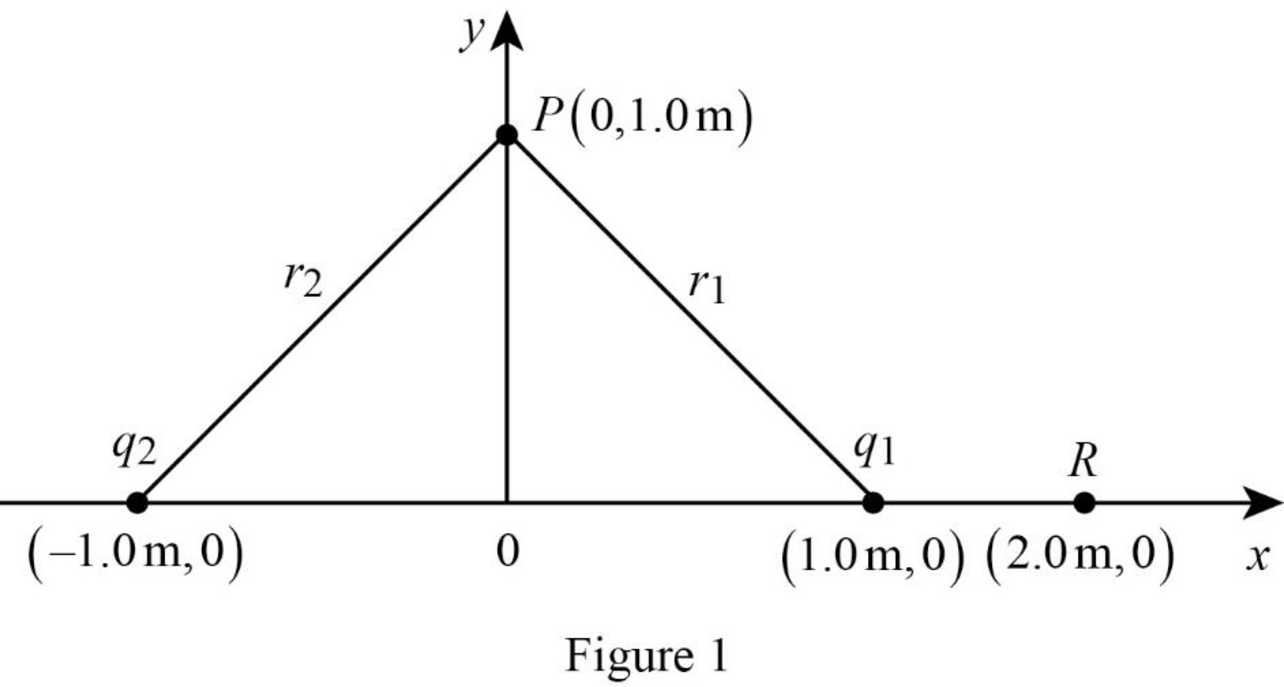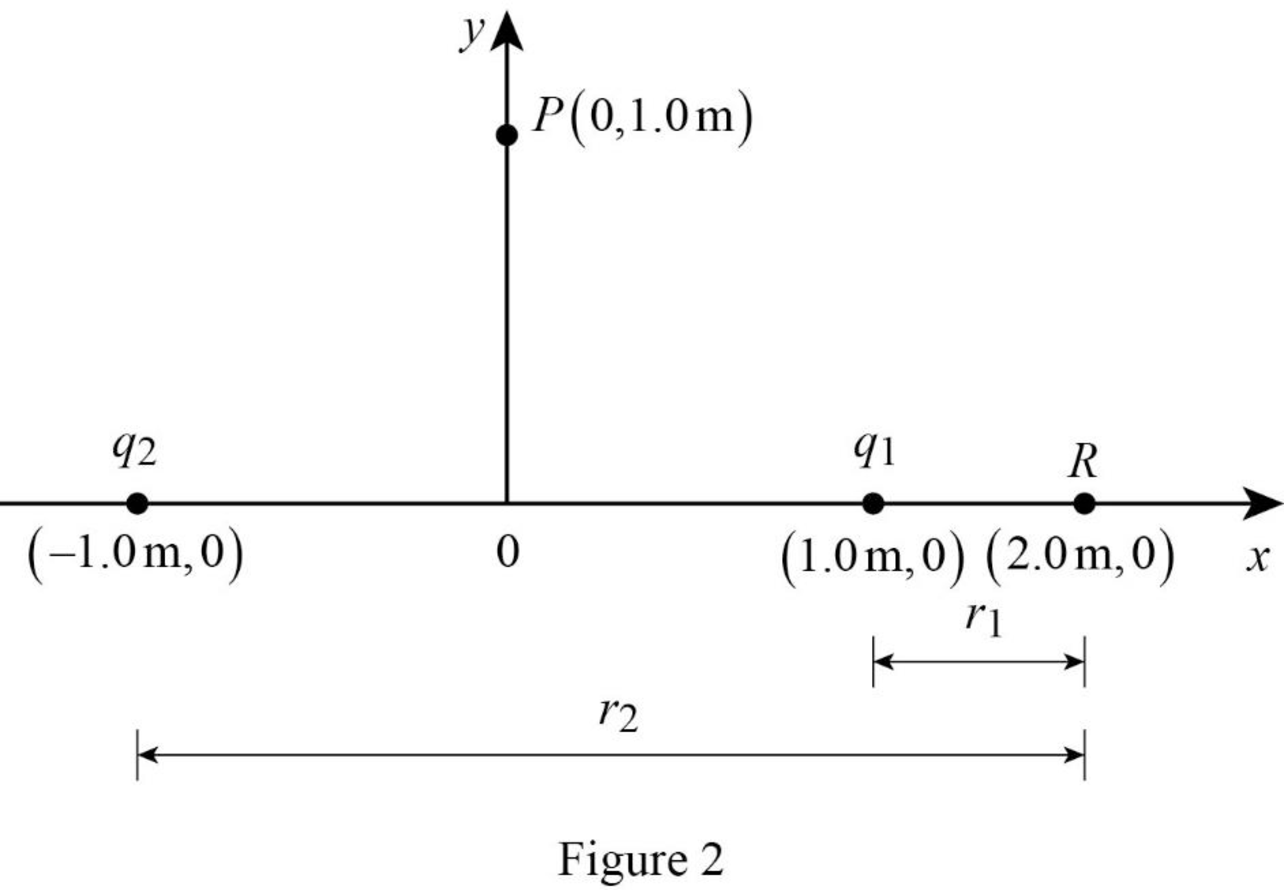
Concept explainers
Two point charges, q1 = −2.0 μC and q2 = 2.0 μC, are placed on the x axis at x = 1.0 m and x = −1.0 m, respectively (Fig. P26.24).
- a. What are the electric potentials at the points P (0, 1.0 m) and R (2.0 m, 0)?
- b. Find the work done in moving a 1.0-μC charge from P to R along a straight line joining the two points.
- c. Is there any path along which the work done in moving the charge from P to R is less than the value from part (b)? Explain.
(a)
The electric potential at
Answer to Problem 24PQ
The electric potential at
Explanation of Solution
Write the expression for electric potential due to two charges.
Write the expression for distance between two points.
Conclusion:
Consider the figure 1 below.

Substitute,
Substitute,
Substitute,
Consider figure 2 given below.

Substitute,
Substitute,
Substitute,
Therefore, the electric potential at
(b)
The work done in moving a
Answer to Problem 24PQ
The work done in moving a
Explanation of Solution
The work done will be equal to change in potential energy between two points.
Write the expression for change in electric potential energy.
Here,
Conclusion:
Substitute,
Therefore, the work done in moving a
(c)
The path along which the work done is less than the value obtained in part (b).
Answer to Problem 24PQ
No, there is no other path through which the charge can move so that the work done is less than the value obtained part (b).
Explanation of Solution
Write the expression for work done in terms of change in potential energy.
The work done is depends on charge and the change in potential, and does not depends on the path followed by the particle.
Hence, there is no other path in which work done is less than
Conclusion:
Therefore, the work done is not depends on the path followed by the particle, and only depends on the change in potential. There is no other path with work done less than
Want to see more full solutions like this?
Chapter 26 Solutions
Physics for Scientists and Engineers: Foundations and Connections
- Figure P26.44 shows a rod of length = 1.00 m aligned with the y axis and oriented so that its lower end is at the origin. The charge density on the rod is given by = a + by, with a = 2.00 C/m2 and b = 1.00 C /m2. What is the electric potential at point P with coordinates (0, 25.0 cm)? A table of integrals will aid you in solving this problem.arrow_forwardFigure P26.80 shows a wire with uniform charge per unit length = 2.25 nC/m comprised of two straight sections of length d = 75.0 cm and a semicircle with radius r = 25.0 cm. What is the electric potential at point P, the center of the semicircular portion of the wire? FIGURE P26.80arrow_forwardThree particles with equal positive charges q are at the corners of an equilateral triangle of side a as shown in Figure P20.10. (a) At what point, if any, in the plane of the particles is the electric potential zero? (b) What is the electric potential at the position of one of the particles due to the other two particles in the triangle? Figure P20.10arrow_forward
- An infinite number of charges with q = 2.0 C are placed along the x axis at x = 1.0 m, x = 2.0 m, x = 4.0 m, x = 8.0 m, and so on, as shown in Figure P26.78. Determine the electric potential at the point x = 0 due to this set of charges. Hint: Use the mathematical formula for a geometric series, 1+r+r2+r3+r4+=11r FIGURE P26.78arrow_forwardFour particles are positioned on the rim of a circle. The charges on the particles are +0.500 C, +1.50 C, 1.00 C, and 0.500 C. If the electric potential at the center of the circle due to the +0.500 C charge alone is 4.50 104 V, what is the total electric potential at the center due to the four charges? (a) 18.0 104 V (b) 4.50 104 V (c) 0 (d) 4.50 104 V (e) 9.00 104 Varrow_forwardA uniformly charged insulating rod of length 14.0 cm is bent into the shape of a semicircle as shown in Figure P20.29. The rod has a total charge of 7.50 C. Find the electric potential at O, the center of the semicircle. Figure P20.29arrow_forward
- A uniformly charged filament lies along the x axis between x = a = 1.00 m and x = a + = 3.00 m as shown in Figure P25.66. The total charge on the filament is 1.60 nC. Calculate successive approximations for the electric potential at the origin by modeling the filament as (a) a single charged particle at x = 2.00 m, (b) two 0.800-nC charged particles at x = 1.5 m and x = 2.5 m, and (c) four 0.400-nC charged particles at x = 1.25 m, x = 1.75 m, x = 2.25 m, and x = 2.75 m. (d) Explain how the results compare with the potential given by the exact expression v=klQlln(l+aa)arrow_forwardA source consists of three charged particles located at the vertices of a square (Fig. P26.32), where the square has sides of length 0.243 m. The charges are q1 = 35.0 nC, q2 = 65.0 nC, and q3 = 56.5 nC. Find the electric potential at point A located at the fourth vertex. FIGURE P26.32 Problems 32 and 33.arrow_forwardThe three charged particles in Figure P25.22 are at the vertices of an isosceles triangle (where d = 2.00 cm). Taking q = 7.00 C, calculate the electric potential at point A, the midpoint of the base.arrow_forward
- Two charged particles with q1 = 5.00 C and q2 = 3.00 C are placed at two vertices of an equilateral tetrahedron whose edges all have length s = 4.20 m (Fig. P26.37). Determine what charge q3 should be placed at the third vertex so that the total electric potential at the fourth vertex is 2.00 kV. FIGURE P26.37arrow_forwardA filament running along the x axis from the origin to x = 80.0 cm carries electric charge with uniform density. At the point P with coordinates (x = 80.0 cm, y = 80.0 cm), this filament creates electric potential 100 V. Now we add another filament along the y axis, running from the origin to y = 80.0 cm. carrying the same amount of charge with the same uniform density. At the same point P, is the electric potential created by the pair of filaments (a) greater than 200 V, (b) 200 V, (c) 100 V, (d) between 0 and 200 V, or (e) 0?arrow_forwardAn infinite number of charges with |q| =2.0 C are placed along the x axis at x = 1.0 m, x = 2.0 m, x = 4.0 m, x = 8.0 m, and so on, as shown in Figure R26.79. What will be the electric potential at x = 0 if the consecutive charges have alternating signs as shown in Figure P26.79? Hint: Use the mathematical formula for a geometric series, 1+r+r2+r3+r4+=11r FIGURE P26.79arrow_forward
 Physics for Scientists and Engineers: Foundations...PhysicsISBN:9781133939146Author:Katz, Debora M.Publisher:Cengage Learning
Physics for Scientists and Engineers: Foundations...PhysicsISBN:9781133939146Author:Katz, Debora M.Publisher:Cengage Learning College PhysicsPhysicsISBN:9781285737027Author:Raymond A. Serway, Chris VuillePublisher:Cengage Learning
College PhysicsPhysicsISBN:9781285737027Author:Raymond A. Serway, Chris VuillePublisher:Cengage Learning College PhysicsPhysicsISBN:9781305952300Author:Raymond A. Serway, Chris VuillePublisher:Cengage Learning
College PhysicsPhysicsISBN:9781305952300Author:Raymond A. Serway, Chris VuillePublisher:Cengage Learning Principles of Physics: A Calculus-Based TextPhysicsISBN:9781133104261Author:Raymond A. Serway, John W. JewettPublisher:Cengage Learning
Principles of Physics: A Calculus-Based TextPhysicsISBN:9781133104261Author:Raymond A. Serway, John W. JewettPublisher:Cengage Learning Physics for Scientists and Engineers, Technology ...PhysicsISBN:9781305116399Author:Raymond A. Serway, John W. JewettPublisher:Cengage Learning
Physics for Scientists and Engineers, Technology ...PhysicsISBN:9781305116399Author:Raymond A. Serway, John W. JewettPublisher:Cengage Learning Physics for Scientists and EngineersPhysicsISBN:9781337553278Author:Raymond A. Serway, John W. JewettPublisher:Cengage Learning
Physics for Scientists and EngineersPhysicsISBN:9781337553278Author:Raymond A. Serway, John W. JewettPublisher:Cengage Learning





